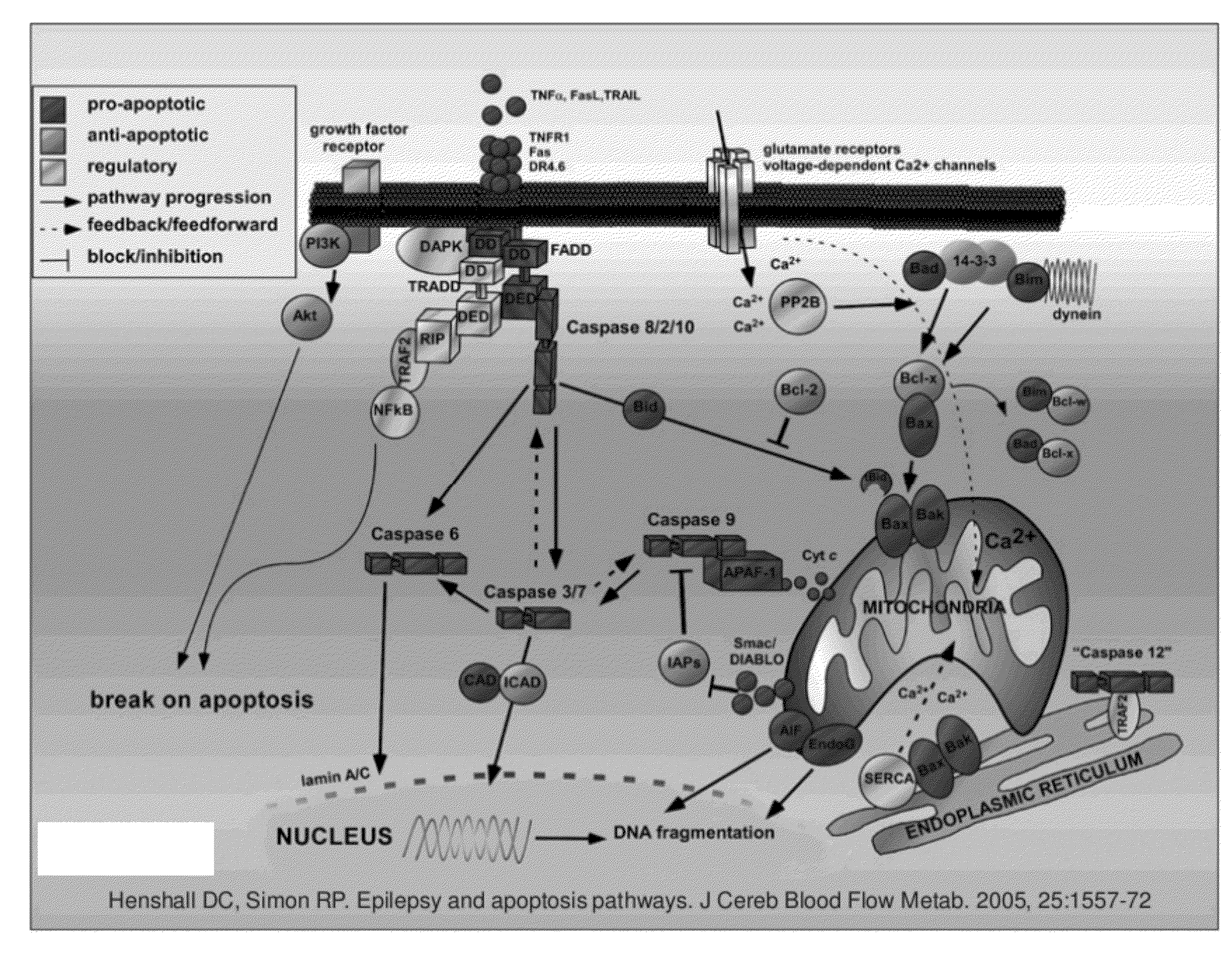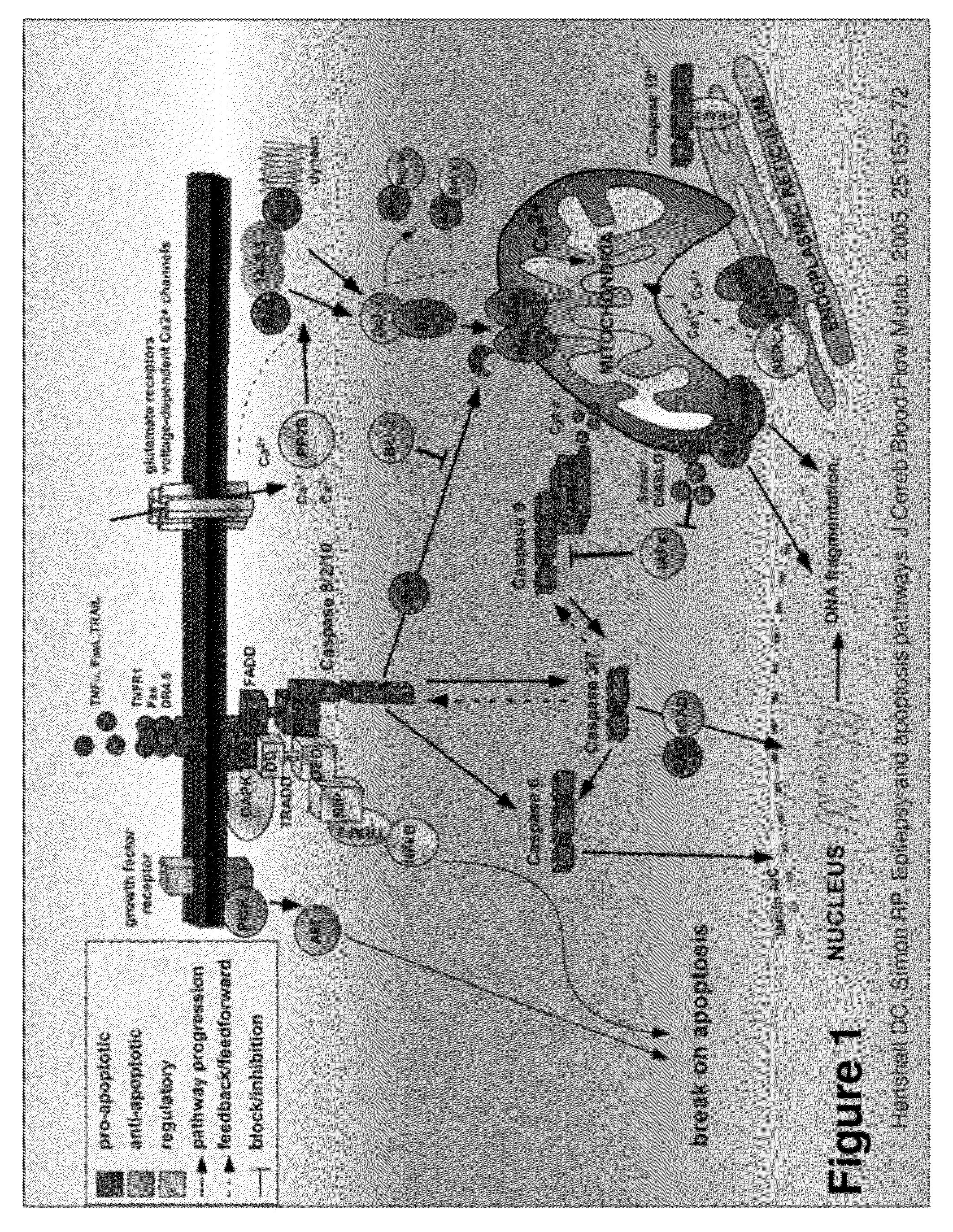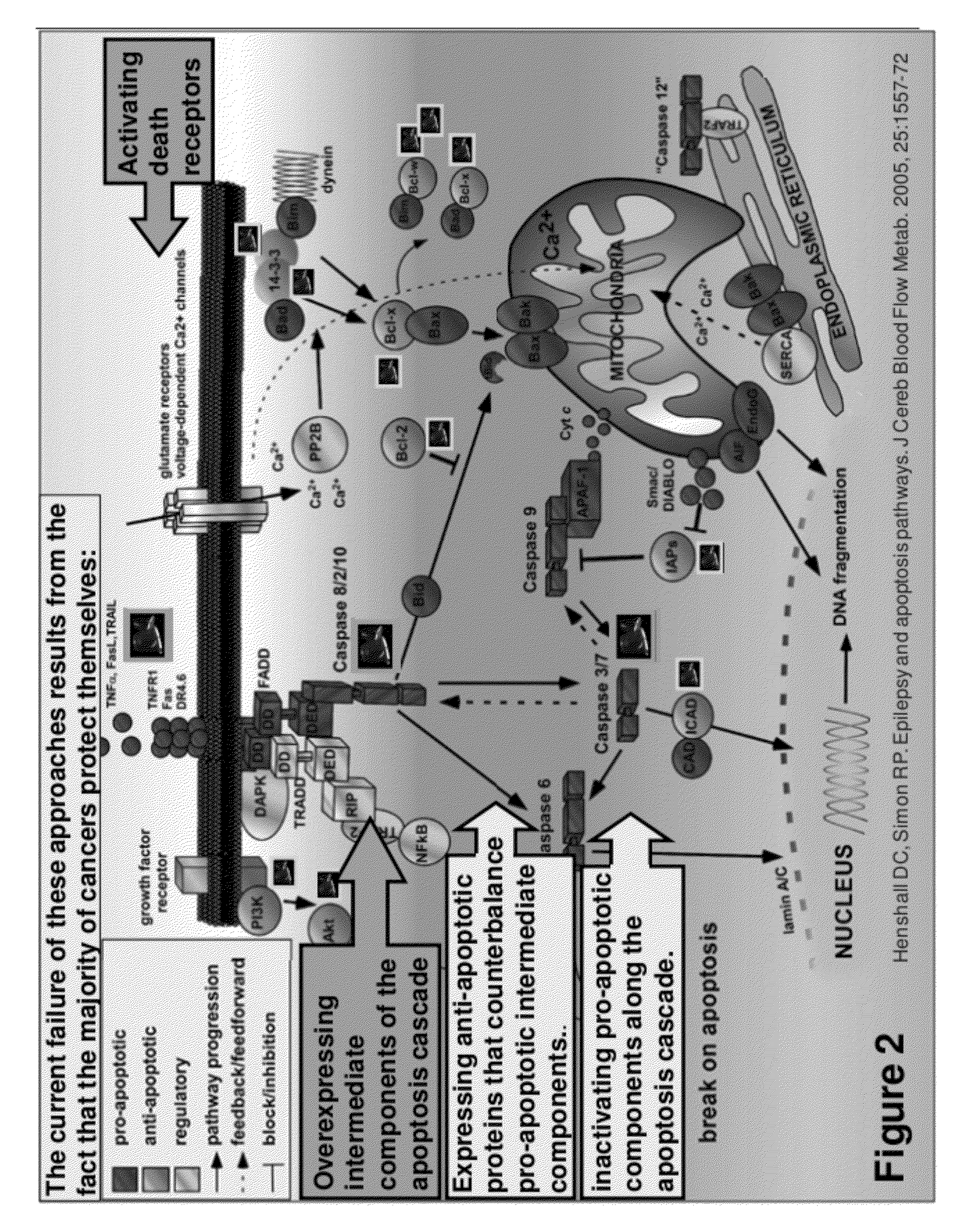[0074]One very important
advantage of the present invention is the ability of the gene constructs to activate apoptosis without triggering the apoptosis
cascade that would normally be triggered in classical apoptosis-inducing therapies such as
suicide gene therapy. The gene constructs of the present invention bypass all negative and positive inhibitory feedbacks that generally exist with programmed-cell-death executioner genes in order to destroy a targeted cell. The negative and positive inhibitory feedbacks are present at almost every level along the apoptosis cascade. The gene constructs of the present invention deliver the final
effector of apoptosis, activated DNases, to their normal
site of action, the
nucleoplasm. One benefit of using the gene constructs of the present invention is that the number of patients that are able to respond to anti-
cancer treatment is increased because the gene constructs of the present invention bypass many of the main treatment-resistant mechanisms of cancer, i.e. the apoptosis cascade. This is accomplished by triggering the chain of morphological, cancer-cell disintegration events from the last component of the apoptosis cascade. This is in contrast to current
suicide gene therapies for cancer that use activating death-receptors (CD95,
tumor necrosis factor (TNF)) at the beginning of the apoptosis cascade, or overexpressing intermediate apoptosis-cascade / cell-cycle components (Caspases, p53), which are dependent on an intact down-
stream chain of components. The gene constructs of the present invention can therefore be used in patients that are resistant to apoptosis-inducing gene therapies such as
suicide gene therapy. Also, the gene constructs of the present invention are able to be used in patients that are resistant to other apoptosis-inducing treatments such as radiotherapy and
chemotherapy. Therefore, a method of treating cancer (or any other
disease as described herein) is provided by activating apoptosis of cancer cells (or any other desired cells) without triggering the apoptosis cascade.
[0075]Essentially, the gene constructs can be used to target any
disease that has specific markers in the diseased cells. The gene construct can be targeted to promoters that are present in diseased cells, so that they can be selectively eliminated, leaving healthy cells intact. The gene constructs can be used to treat many different kinds of cancers, preferably malignant
melanoma, but also
prostate cancer,
lymphoma,
leukemia,
throat, pancreatic,
thyroid, ovarian, neuroendocrine (
small cell lung cancer,
neuroblastoma, carcinoid), or medullary
thyroid cancer. Preferably, the cancer is in a tissue or organ that possesses a specific
promoter /
enhancer that can be used to target the gene construct'
s expression. In malignant
melanoma, only melanocytic cells contain promoters for genes involved in the synthesis of the
melanin pigment. The gene constructs can also be used to treat infectious diseases such as, but not limited to, HIV, AIDS,
malaria, and
Leishmania. The gene construct can also be used to eliminate specific cells, such as, but not limited to, subtypes of immune cells that are involved in the
etiology of chronic inflammatory diseases such as
rheumatoid arthritis,
inflammatory bowel disease (Crohn's
disease,
ulcerative colitis), or graft-versus-
host disease (GVHD). Any disease that involves specific types of T cells can also be targeted. While cancer cells are specifically discussed, it should be understood that the methods herein apply to any cells desired to be eliminated from a patient, provided that they produce a unique
protein to the targeted tissue / organ.
[0076]A method of eliminating undesired cells from a patient is provided, including the steps of administering a therapeutic containing a gene construct, delivering the therapeutic to undesired cells, and destroying the cells. Preferably, this method is used to treat cancer, especially malignant
melanoma, and the undesired cells are cancerous or tumorous cells. The gene construct is administered in the envelope as described above, through the use of a
gene gun or injection. Other methods of administration are further described below. The gene construct is preferentially delivered to the undesired cells and not healthy cells due to the surface receptors that direct the envelope and its content to the undesired cells. The gene constructs are able to
gain access to the
nucleus due to their modifications as described above and destroy the cell. In summary, removing the signal peptides prevents the cell from packing the gene construct in an
endosome and shipping it out of the cell (secreting the gene construct). Adding an NLS provides the gene construct an access into the
nucleus; hence, it can come in vicinity to the target DNA in order to defragment it. Knocking down the
binding site for
actin prevents actin from inhibiting the gene construct.
[0077]More specifically, a method is provided of treating malignant melanoma by administering a therapeutic containing a genetically
modified DNA-degrading
enzyme at the core of a gene construct, such as a hrDNase 1 gene construct, delivering the therapeutic to melanoma cancer cells, and destroying the melanoma cancer cells. The treatment is advantageous over other prior art treatments, because the gene constructs include components that limit the expression to targeted cells and not non-targeted cells, and the envelope used for delivery of the gene construct includes surface homing receptors that target the gene construct to the tissue of choice, thereby allowing the gene construct to accumulate in the targeted tissue and further reducing side effects for the patient, as further described below.
[0078]The therapeutics of the present invention enable treatment of cancer in patients with a compromised
immune system, or even a severely compromised
immune system, since they do not require the participation of the
immune system. This is in contrast to current cancer therapies that are immunotherapeutic approaches and dependent on the recruitment of a patient's immune
system in order to fully function. A substantial number of patients having cancer metastases also have deficiencies in their immune
system functions. The present invention can therefore treat more patients than other current therapies due to the fact that a fully functioning immune
system is not required for effectiveness of the therapeutics herein.
[0079]Therefore, a method is provided of treating a cancer patient having a compromised immune system, by administering a therapeutic containing a gene construct to a patient having a compromised immune system, delivering the therapeutic to
tumor cells, destroying the
tumor cells, and treating cancer.
 Login to View More
Login to View More 


